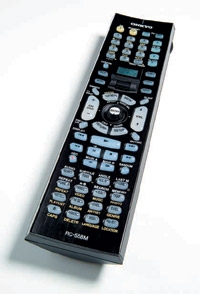Onkyo TX-NR1000 Digital Surround Receiver Page 3
| PLUS •Superb audio/video performance. •Innovative, upgradable modular design. •Net-Tune Internet radio capability. •Ethernet, i.Link, and HDMI ports. •Upconverts composite/S-video to component video/HDMI. MINUS •Can't play audio signals via HDMI input. |
Voilà! I could play MP3, WMA, and WAV files on my computer using the Net-Tune software and listen through the receiver, using its Music Server source setting. Moreover, I could use the receiver to tune to Internet radio stations and listen to those, too. Its Internet Radio source setting let me select genres, locations, and languages - the receiver accesses the XiVA-net online database to see what stations are available and lets you preset 30 Net radio stations. The TX-NR1000 even displays buffering status as streaming files are received. Of course, Net radio is not the greatest fidelity, but still way fun.
 Despite its inherent complexity, the receiver was pretty straightforward to configure and operate. Onkyo prides itself on simple menus, and the supplied RC-558M learning remote is itself a minor work of art. It has terrific heft thanks to its aluminum front panel and is beautifully styled with glossy backlit buttons, a central joystick, a scroll wheel on the side, and an LCD to keep track of things. To switch between source components, just spin the scroll wheel. The remote also lets you program macros (a series of commands invoked by a single button push).
Despite its inherent complexity, the receiver was pretty straightforward to configure and operate. Onkyo prides itself on simple menus, and the supplied RC-558M learning remote is itself a minor work of art. It has terrific heft thanks to its aluminum front panel and is beautifully styled with glossy backlit buttons, a central joystick, a scroll wheel on the side, and an LCD to keep track of things. To switch between source components, just spin the scroll wheel. The remote also lets you program macros (a series of commands invoked by a single button push).
MUSIC PERFORMANCE Of course, all the features under the sun aren't worth much if the audio integrity isn't combat-ready. To check that, I listened to a wide range of stereo and surround discs, focusing mainly on recordings of acoustic instruments, which to my ear are the hardest to reproduce realistically. For example, on the surround mix of Blues Traveler's Truth Be Told, I listened to "Thinnest of Air." This upbeat song features a rollicking Ben Wilson organ part, snappy John Popper harmonica licks, and quick interplays between Brendan Hill's high hat and cymbals and Chandler Kinchla's guitar. It's very complex music.
The massive TX-NR1000 proved to be perfectly nimble with this track, conveying it without adding or subtracting anything. And that's good - an amplifier's job is simply to provide gain, not to contribute any sound of its own. It lacks literary drama, but the highest compliment I can pay any amplifier is to call it transparent. The TX-NR1000 was transparent. Moreover, its arsenal of 150-watt channels provided plenty of firepower, allowing me to pound my listening room (and probably my hearing) with extremely high sound-pressure levels. This receiver can knock out enemy amplifiers with ease. On the measure of sound quality, and the ability to deliver loud and clean power, the TX-NR1000 rates among the best I've ever heard.
Likewise, while I'm not usually enamored of ancillary surround modes (most of which are gimmicky and unnatural), I was impressed by what Onkyo provides on this front. As an example, the Orchestra mode very tastefully opened up the surround sound field to provide realistic hall ambience. All in all, in today's video-centric world, this receiver takes its audio obligations seriously.
MOVIE PERFORMANCE Turning to the cinema side of things, I checked out Touching the Void. This quasi-documentary, a re-enactment of actual events, is one of the best films I've seen recently. It tells the epic cliff-hanging tale of two mountaineers climbing the west face of Siula Grande, a 21,000-foot mountain in the Peruvian Andes, and living (barely) to tell about it.
The sound quality from the movie's Dolby Digital soundtrack was superb. The understated score sparsely and spookily comments on events as they unfold, foretelling catastrophe. But the film's primary accompaniment is the sound of wind, which alternately whispers or howls through the surround sound field, clearly communicating the overwhelming forces of nature at work. Can 150 watts x 7 convey the sound of a gale-force wind? You bet. The musical score, the effects, and the dialogue were as vivid as anything I've heard. I was impressed by the raw audio power under the hood.
I also checked both the HDMI and component-video outputs. These were as impressive as the sound, adding no detectable noise or disturbing artifacts to the digital source. The film's high-altitude cinematography looked simply awesome on my Samsung DLP rear projector. From both an aural and visual standpoint, the Onkyo is a movie lover's dream come true.
BOTTOM LINE Could you go into battle riding something less awesome than an M1A1/M1A2 tank? Sure. But would you really want to? Likewise, you could probably enjoy movies and music with a run-of-the-mill receiver. But if you really want extreme operational flexibility, devastating firepower, protection from obsolesence, and sheer strength of build quality to back it all up, then choose the TX-NR1000. It's a devastating weapon in the battle for home theater supremacy.
Click here to view full lab results.













































